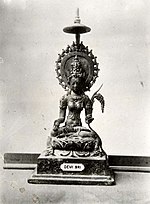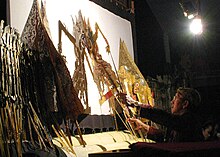
Back وايانج Arabic Vayanq Azerbaijani ওয়ায়াং Bengali/Bangla ཝ་ཡང་ཟློས་གར་ཁང་། Tibetan Wayang Catalan Wayang Czech Wayang German Vajango Esperanto Wayang Spanish Wayang Basque
This article needs additional citations for verification. (April 2024) |
| Wayang | |
|---|---|
 | |
| Types | Traditional puppet theatre |
| Ancestor arts | Javanese people |
| Originating culture | Indonesia |
| Originating era | Hindu - Buddhist civilisations |
| Wayang puppet theatre | |
|---|---|
| Country | Indonesia |
| Reference | 00063 |
| Region | Asia and the Pacific |
| Inscription history | |
| Inscription | 2008 (3rd session) |
| List | Representative |
| Wayang kulit (the leather shadow puppet), Wayang klitik (the flat wooden puppet), wayang golek (the three-dimensional wooden puppet) | |
| This article is a part of the series on |
| Indonesian mythology and folklore |
|---|
 |
|
|

Wayang (Javanese: ꦮꦪꦁ, romanized: wayang (in the ngoko register), ꦫꦶꦁꦒꦶꦠ꧀, ringgit (in the krama register))[1] is a traditional form of puppet theatre play originating from the Indonesian island of Java.[2][3][4] Wayang refers to the entire dramatic show. Sometimes the leather puppet itself is referred to as wayang.[5] Performances of wayang puppet theatre are accompanied by a gamelan orchestra in Java, and by gender wayang in Bali. The dramatic stories depict mythologies, such as episodes from the Hindu epics the Ramayana and the Mahabharata, as well as local adaptations of cultural legends.[3][6][7] Traditionally, a wayang is played out in a ritualized midnight-to-dawn show by a dalang, an artist and spiritual leader; people watch the show from both sides of the screen.[3][6]
Wayang performances are still very popular among Indonesians, especially in the islands of Java and Bali. Wayang performances are usually held at certain rituals, certain ceremonies, certain events, and even tourist attractions. In ritual contexts, puppet shows are used for prayer rituals (held in temples in Bali),[8] ruwatan ritual (cleansing Sukerto children from bad luck),[9] and sedekah bumi ritual (thanksgiving to God for the abundant crops).[10] In the context of ceremonies, usually it is used to celebrate mantenan (Javanese wedding ceremony) and sunatan (circumcision ceremony). In events, it is used to celebrate Independence Day, the anniversaries of municipalities and companies, birthdays, commemorating certain days, and many more. Even in the modern era with the development of tourism activities, wayang puppet shows are used as cultural tourism attractions.[11]
Wayang traditions include acting, singing, music, drama, literature, painting, sculpture, carving, and symbolic arts. The traditions, which have continued to develop over more than a thousand years, are also a medium for information, preaching, education, philosophical understanding, and entertainment.[12]
UNESCO designated wayang – the flat leather shadow puppet (wayang kulit), the flat wooden puppet (wayang klitik), and the three-dimensional wooden puppet (wayang golek) theatre, as a Masterpiece of the Oral and Intangible Heritage of Humanity on 7 November 2003. In return for the acknowledgment, UNESCO required Indonesians to preserve the tradition.[13]
- ^ Robson & Wibisono 2002, pp. 803–804.
- ^ ""Wayang puppet theatre", Inscribed in 2008 (3.COM) on the Representative List of the Intangible Cultural Heritage of Humanity (originally proclaimed in 2003)". UNESCO. Retrieved 10 October 2014.
- ^ a b c "Wayang: Indonesian Theatre". Encyclopaedia Britannica. 2012.
- ^ "History and Etymology for Wayang". Merriam-Webster. Retrieved 22 December 2020.
- ^ Siyuan Liu (2016). Routledge Handbook of Asian Theatre. Routledge. pp. 72–81. ISBN 978-1-317-27886-3.
- ^ a b Don Rubin; Chua Soo Pong; Ravi Chaturvedi; et al. (2001). The World Encyclopedia of Contemporary Theatre: Asia/Pacific. Taylor & Francis. pp. 184–186. ISBN 978-0-415-26087-9.
- ^ Yves Bonnefoy (1993). Asian Mythologies. University of Chicago Press. p. 162. ISBN 978-0-226-06456-7.
- ^ ""Pertunjukan Wayang Kulit sebagai Atraksi Budaya Baik atau Buruk?"". www.kompasiana.com. 15 December 2019. Retrieved 13 February 2021.
- ^ ""Dalang Ruwat, Profesi Tak Sembarangan Ki Manteb Soedharsono"". www.cnnindonesia.com. Retrieved 13 February 2021.
- ^ ""Sedekah Bumi dan Wayang Kulit, Cara Bersyukur Petani Atas Panennya"". www.jawapos.com. 10 October 2018. Retrieved 13 February 2021.
- ^ ""Wayang Seni Ritual, Dulu Dimainkan Oleh Saman"". www.balihbalihan.com. 12 June 2020. Retrieved 13 February 2021.
- ^ ""Wayang: Aset Budaya Nasional Sebagai Refleksi Kehidupan dengan Kandungan Nilai-nilai Falsafah Timur"". Indonesian Ministry of Education and Culture (Kemdikbud). Retrieved 8 January 2021.
- ^ ""Wayang puppet theatre", Inscribed in 2008 (3.COM) on the Representative List of the Intangible Cultural Heritage of Humanity (originally proclaimed in 2003)". UNESCO. Retrieved 10 October 2014.